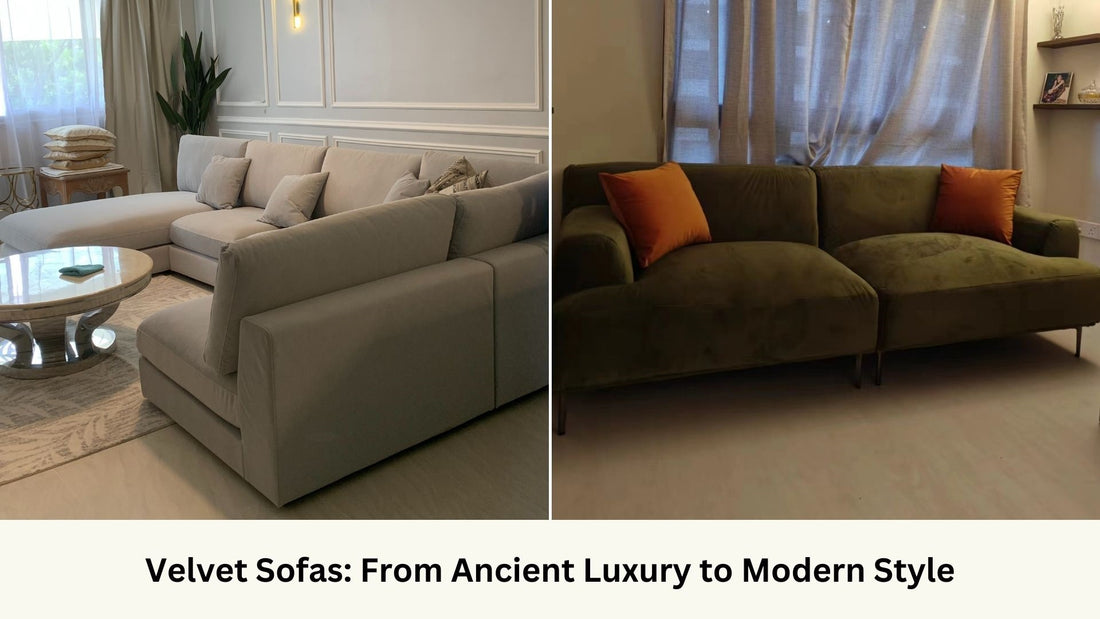
Velvet Sofas: From Ancient Luxury to Modern Style
Share
Velvet sofas offer the perfect blend of style and practicality. With proper care, their luxurious texture and durability make them a stunning addition to any modern home.
Read on to find out more about what it is, its history, manufacturing process and styling guide for velvet sofas.
What is Velvet: How it Looks and Feels
Velvet is a luxurious fabric, known for its soft, plush feel and a distinct shimmer that changes based on how the light hits it. The fabric’s pile, or raised surface, gives it a unique texture that feels smooth to the touch. Its luxurious appearance often makes it synonymous with opulence and elegance, adding a touch of richness to any interior or garment.
History of Velvet
Velvet has a long and fascinating history, stretching back over 4,000 years. It is believed that velvet originated in China and spread to Europe through the Silk Road. The fabric made its way into the Arab world, where it was referred to as "Kutuf" in Syria. Historical records show velvet being mentioned as early as 1311 AD.
Initially, velvet was so expensive that it was reserved exclusively for the wealthy. Special laws even dictated who could own and wear it. Velvet was a symbol of status, worn by royalty and the upper classes. However, the Industrial Revolution in the 19th century democratized velvet, making it accessible to a wider audience for the first time. Its association with Bohemian culture grew in popularity, cementing its place as both a luxurious and artistic fabric.
Composition of Velvet
Traditional velvet was woven from pure silk, making it one of the most costly fabrics available. Over time, advancements in fabric technology introduced synthetic materials like polyester, nylon, and rayon into velvet production. These materials allowed manufacturers to offer more affordable versions without compromising on the fabric's signature texture and appearance.
How Velvet is Made
The process of making velvet remains unchanged, regardless of whether it’s made with silk or synthetic fibers. Velvet is woven on a unique loom that spins two layers of fabric simultaneously. These layers are then carefully cut down the middle, producing two separate pieces of velvet.

After this, the fabric is dyed and finished, often going through a tumbling and brushing process to enhance its softness and texture. Sometimes, a backing fabric is applied for added stability.
Types of Velvet
Several types of velvet are available, each with its own distinctive look and feel:
-
Ciselé Velvet: Features patterns created by cutting some of the loops in the pile, leaving other parts uncut. This creates a textured, intricate look, often used for upholstery or statement garments.
-
Crushed Velvet: Characterized by a permanently wrinkled texture that gives it a rich, shiny appearance. It’s commonly used in fashion and furniture for a striking, lived-in effect.
-
Devoré Velvet: A semi-transparent velvet, where certain areas are chemically burned away to create patterns. It’s often used in scarves, blouses, and elegant home furnishings.
-
Embossed Velvet: Patterns are pressed onto the velvet's surface using heat, resulting in a raised design. This type is used in high-end fashion and upholstery.
-
Lyons Velvet: This dense and stiff velvet has a short pile, traditionally made from silk. It’s used primarily for formal attire and luxurious upholstery.
-
Panne Velvet: With its pressed, flattened pile, panne velvet has a glossy finish and is commonly used for apparel, particularly in evening wear.
-
Stretch Velvet: Made with elastane or spandex, this type of velvet is both soft and stretchy, often used in dancewear or form-fitting clothing.
-
Velour Velvet: A knitted form of velvet, velour is stretchy and durable, making it popular in casual clothing and home furnishings like sofas.
Why Velvet Works Great on Sofas
Velvet is an good fabric choice for sofas because of its unique combination of luxury, comfort, and durability. Its soft texture provides a cozy, inviting feel, making it perfect for lounging. Additionally, velvet’s dense weave makes it durable, allowing it to withstand everyday use without easily showing wear. The rich, shimmery surface of velvet adds visual depth, giving any sofa a bold, elegant presence in a room. Its ability to reflect light enhances the vibrancy of its color, making it perfect for both subtle neutrals and statement tones. Finally, velvet’s flat pile makes it resistant to pet claws and easy to clean, making it a practical yet stylish choice for modern homes.
How to Style with a Velvet Sofa
A velvet sofa can become the statement piece in any living room. Its vibrant colors and soft, shimmery texture can instantly uplift a space, creating a sense of luxury and elegance. For those looking to make a bold, bright design choice, a velvet sofa in deep jewel tones or rich hues is perfect. The fabric’s rich texture also pairs well with metallic accents, adding depth and sophistication to any room.
How to Care for Velvet
To keep velvet looking its best, avoid exposing it to direct sunlight, as this can cause the fabric to fade. Use the flat side of a soft, double-sided brush to remove lint, dirt, and pet hair. If the fabric begins to lose its sheen, brushing against the pile will restore its luster. Regular vacuuming helps to remove dust particles, and gentle care ensures that velvet retains its beauty over time.
Velvet's enduring elegance and practicality make it a fantastic choice for anyone seeking to add a touch of luxury to their home while maintaining family-friendly durability.
Published: 31st Oct 2024
